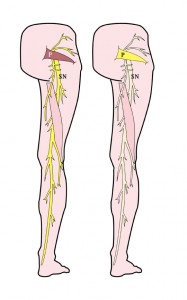Creating Space For Sciatic Nerve Pain
Sciatic nerve pain can happen for a number of different reasons.
For one, the sciatic nerve is the longest nerve in the body which provides ample opportunity for different types of impingement.
Technically the sciatic nerve forms in the pelvic region as five nerve roots flow out of the bottom of the spinal cord, move into and through the pelvis, to band together as the peroneal and tibial nerves encased in the sciatic sheath directly in front of the piriformis muscle.
The piriformis muscle is one of only three muscles connecting the legs to the pelvis.
If the body is aligned well skeletally and muscularly, there will be very little strain on the piriformis.
On the other hand, if the body is not well aligned then all three of these muscles (gluteus maximus and psoas being the others) will suffer in the unsuccessful attempt to support a load they weren’t designed to bear.
Though there are a number of spinal conditions that can lead to sciatic nerve pain, such as herniated discs and spondylosis, as either bone or disc can press on the sciatic nerve, a piriformis muscle that is tight or in spasm is one of the main causes of sciatic nerve pain under the guise of piriformis syndrome.
It might sound simple but one of the most effective ways to alleviate sciatic nerve pain is to create more space for the sciatic nerve to flow freely.
That can be done most effectively by changing your movement patterns and posture because often they are a major reason the sciatic nerve becomes impinged.
There are also numerous exercises that can help to create space for a sciatic nerve to flow better.
The three videos that follow are a few of my favorites.
It is important to note that although these release exercises are effective in and of themselves, combining them with changes to your walking and standing patterns is the best way to bring permanent change to the body and relieve sciatic nerve pain for good.

